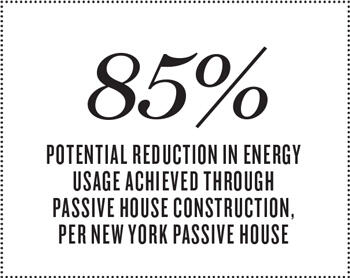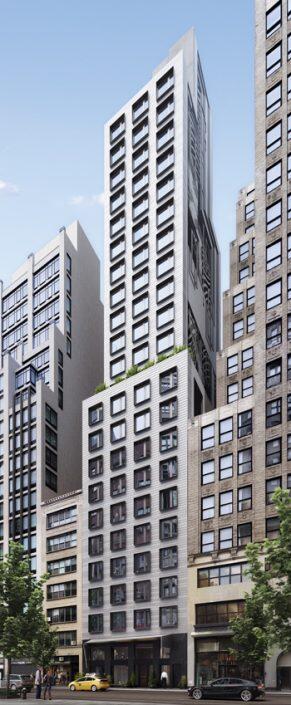Nicholas Liberis knew his office project in Long Island City had to be different.
A new 11-story building surrounded by former warehouses and budget hotels was not exactly a top-of-mind destination for tech giants or hedge funds. Then came a global pandemic, which forced companies to rethink their office footprints entirely.
“You needed every competitive advantage that you could get,” said Liberis, a partner at Archimaera, the Brooklyn-based architecture firm responsible for designing the building, which is called the Oasis.
Liberis believes this advantage will come from a German-inspired design standard for new construction and retrofits known as “passive house.” Intended to achieve dramatic reductions in energy consumption, the design standard also yields buildings that are quieter and have better air quality for tenants, according to advocates.
It’s a concept widely embraced throughout much of Europe, where some municipalities have even begun incorporating it into local building codes.
Despite the advantages of passive house design, it has yet to appeal to the American masses. Upfront costs can be more expensive. Moreover, it’s just not on the radar for landlords and developers who generally prefer to collect rent checks with minimal expenses.
But the concept is gaining steam.
Cornell Tech designed its 26-story residential building on Roosevelt Island to passive house standards. In Boston, a 690-foot-tall condo and office tower is set to be the largest passive house in the United States upon its targeted completion next year.
The real catalyst in New York could be Local Law 97, which will require larger building owners to reduce their carbon emissions by 40 percent by 2030 and 80 percent in 2050. That’s a daunting challenge even for the most energy-efficient buildings, but advocates say passive house standards could be the solution.
“The fact that someone can buy a passive house-principled building and know that… they won’t have to pay an assessment or penalty is a real thing,” said Brooklyn Home Company’s Bill Caleo, who uses passive house techniques in his buildings.
 From Germany to America
From Germany to America
Passive houses have captured architects’ imaginations since the concept first emerged in Germany in the late 1980s. It wasn’t until 2003, though, that the first building adhering to the standards was constructed in the U.S. : a 1,200-square-foot home in Urbana, Illinois.
In the years since then, the Passive House Institute US, a nonprofit founded in 2007, has certified more than 1,000 completed or ongoing projects in North America. To qualify for certification, buildings must adhere to a few key principles.
For one, passive house buildings must be highly insulated to ensure that hot air does not escape through areas of least resistance, known as thermal bridges.
“Buildings lose a lot of energy going through the walls,” said Stas Zakrzewski of the New York architecture firm Zakrzewski + Hyde Architects, which focuses on passive houses.
In addition to being airtight, the building must have windows that are triple-pane, or have at least three glasses.
Overall, passive houses can reduce buildings’ energy consumption by up to 85 percent, according to New York Passive House, an advocacy group.
But building houses with heavier insulation can pose a risk: poor air quality. That’s why passive houses also require an enhanced ventilation system, providing filtered, fresh air 24/7.
In New York City, this concept may sound radical.
Air-conditioning units perched on window ledges are ubiquitous in the summer. And in the winter, when dusty old radiators start clanking, tenants are often forced to open windows to lower temperatures in the absence of thermostats.
But Zakrzewski said passive houses are not complicated and they present an easy way for landlords to reduce energy costs.
“It’s not like you are building a rocket ship,” said Zakrzewski.
Zakrzewski has used passive housing to retrofit large pre-war Victorian homes in Brooklyn’s Ditmas Park. Homeowners wanted to lower their energy bills, which the architect said sometimes climbed as high as $1,000 per month.
Thus far, Zakrzewski’s largest project has been in Chelsea.
Working with developer Alex Bernstein — whose family owns several commercial buildings in the neighborhood — Zakrzewski designed a 25-story, 55-unit passive house apartment building at 211 West 29th Street known as Flow Chelsea.

Flow Chelsea at 211 West 29th Street
In marketing the project, Bernstein initially eschewed the “passive house” label, instead playing up the benefits of the design, one of which is quietness.
“You can be on the second and third floor and not hear anything,” said Bernstein. “You really are amazed by how quiet the apartments are.”
Brooklyn Home Company’s Caleo said that he was attracted to another benefit of passive homes: air quality. Citing studies about how filtered air affects cognitive brain activity, he believes that passive homes — which must provide constant flowing fresh air — can improve tenants’ health.
“We are trying to sell amenities like Sub- Zero,” said Caleo, who uses passive house technology for new residential projects. “Why are we not selling premium air quality?”
What’s in a name?
Even to their proponents, passive houses have not been the easiest sell.
Although the concept has gained prominence over the years, its devotees still amount to a niche group, largely consisting of academics and the sustainability-minded.
Bernstein said that the name is partly to blame for the lack of awareness.
“Passive house is a terrible name,” he said.
Zakrzewski, who also serves as president of the New York Passive House organization, agreed: “It’s not a great name.”
For one, a passive house is not passive. The concept involves air constantly flowing through a building, which essentially functions as an autonomous entity. Second, the design does not have to be for a house. The technique can be applied to commercial buildings such as offices or hotels, as well as apartment buildings.
Changing a name might help with branding, but landlords and contractors still have to buy in.
Passive house construction can carry an initial premium of 3 to 5 percent on materials and labor, with the goal of reducing those costs down the line, according to industry professionals. However, with rising lumber and material costs across the U.S., those margins are narrowing. Finding contractors and engineers who are certified to design and build passive houses is another challenge.
“It’s a stubborn industry,” said Alan Barlis of the architecture firm BarlisWedlick, which has designed a number of passive homes in upstate New York. “It’s a tight-margin world. Innovation comes with great difficulty.”
Regulation is coming
Passive houses have become particularly popular in such cold-climate regions as Sweden and Canada. Against frigid outdoor conditions, homes require loads of hot air that can escape through the building. This is not only expensive, but also ultimately harmful to the environment.
Some Swedish cities have required new municipal construction to use passive house techniques as part of the country’s plan to reduce carbon emissions. In 2017, the Flemish government moved its headquarters to Belgium’s largest passive office building, in Brussels, where passive house standards have been mandated for new buildings and renovations since 2015.
To date, the U.S. has no federal mandate for building owners to use passive houses. Local Law 97 in New York also does not require the design to be used in construction.
The city is still figuring out the kinks of the law. Zakrzewski, who sits on the Local Law 97 Climate Advisory Board, said that New York “is interested in passive housing,” but declined to give more details.
Even absent any government mandate, passive houses are increasingly popping up throughout the Northeastern United States. One driver could be Covid-19. The pandemic dampened interest in leasing office space, which means that office tenants can afford to be more picky about space.
“It’s a saturated market,” said Liberis. ”People are thinking more about what they are offering.”
One consequence, he said, is that there is now a greater demand for higher quality products, something passive house standards can provide.
“This is really where all the building is going,” he added.
